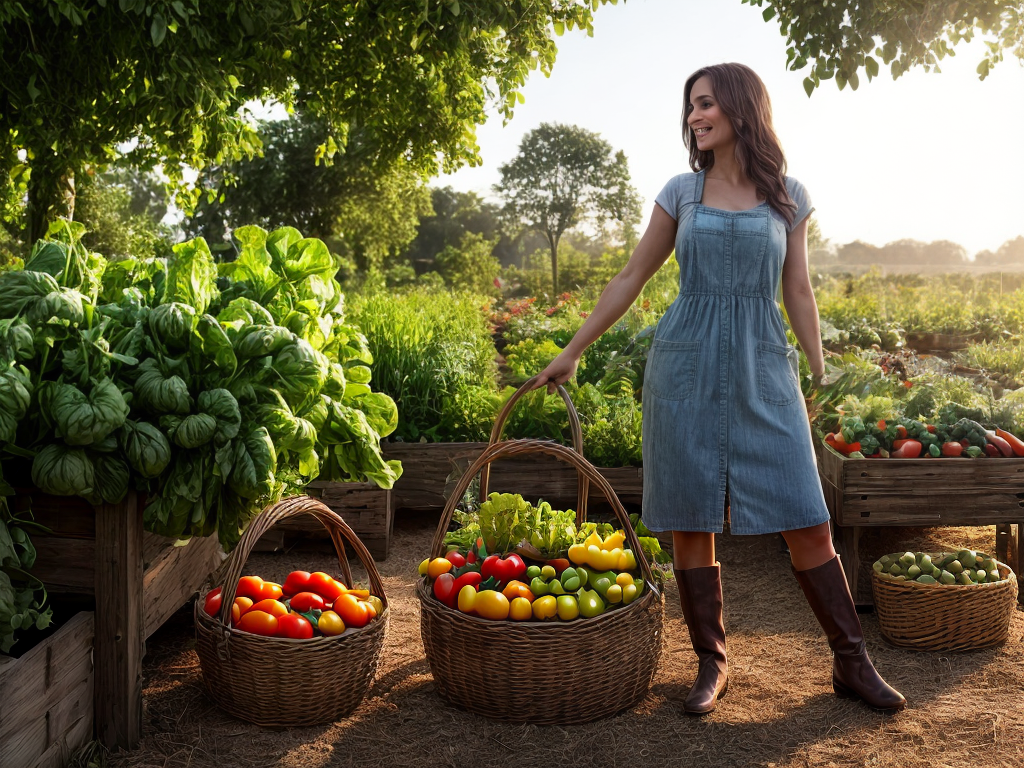
As a proud home gardener, I know the satisfaction that comes from harvesting and storing your own organic vegetables. It’s like a treasure hunt in your own backyard, with the added bonus of knowing exactly what went into growing your food. In this article, I’ll share the techniques I’ve learned for choosing the right time to harvest, proper harvesting techniques, and effective methods for storing your homegrown bounty. Get ready to enjoy the fruits of your labor for months to come!
Choosing the Right Time to Harvest
As a home gardener, I find it crucial to determine the optimal moment to harvest my organic vegetables. One key factor in determining the right time to harvest is the preparation of the soil. Before planting, it is important to ensure that the soil is well-prepared and rich in organic matter. This can be achieved by adding organic fertilizers, such as compost or manure, to enrich the soil with essential nutrients. The organic fertilizer helps promote healthy growth and development of the vegetables, which in turn affects the timing of harvest. Additionally, observing the plant’s growth and maturity is essential. Pay attention to the size, color, and texture of the vegetables. Harvesting too early may result in underdeveloped flavors, while waiting too long may lead to overripe or spoiled produce. By taking these factors into consideration, I can ensure that I harvest my organic vegetables at the peak of their flavor and nutritional value.
Proper Techniques for Harvesting Vegetables
When it comes to harvesting vegetables, timing is crucial. Knowing the right time to harvest each type of vegetable ensures that you get the best flavor and texture. Additionally, how you handle the harvested vegetables is important to maintain their freshness and quality. In the following points, we will discuss the proper techniques for timing your vegetable harvest and how to handle them once they are picked.
Timing for Vegetable Harvesting
I always use proper techniques for harvesting my homegrown organic vegetables. Timing is crucial when it comes to harvesting vegetables at their peak freshness and flavor. To ensure the best quality produce, it is important to pay attention to the signs of vegetable readiness. For leafy greens like lettuce and spinach, harvest when the leaves are crisp and firm. Tomatoes should be picked when they are fully ripe and have a deep, uniform color. For root vegetables such as carrots and beets, wait until they have reached their mature size, and gently pull them out of the soil. It is also important to harvest in the early morning or late evening when temperatures are cooler, as this helps to preserve the flavor and nutrients of the vegetables. By following these best harvesting practices and paying attention to the signs of readiness, you can enjoy the freshest and most flavorful homegrown vegetables.
Handling Harvested Vegetables
One important tip for handling harvested vegetables is to gently remove any excess dirt or debris from the vegetables before storing them. This helps prevent the growth of bacteria and mold during storage. After cleaning, it is essential to handle each vegetable with care to avoid bruising or damaging them. Storing potatoes requires a cool, dark, and well-ventilated area to prevent sprouting. It is best to store them in a burlap or paper bag to allow for air circulation. When it comes to preserving herbs, the best method is to dry them. Harvest the herbs in the morning, before the sun evaporates the essential oils. Tie them together in small bundles and hang them upside down in a warm, dry place. Once dried, store them in an airtight container in a cool, dark location to maintain their flavor and potency.
| Vegetable | Cleaning Method | Storage Method |
|---|---|---|
| Potatoes | Gently brush off any excess dirt. | Store in a cool, dark, and well-ventilated area, in a burlap or paper bag. |
| Herbs | Rinse with cold water and pat dry. | Dry by hanging upside down in a warm, dry place. Store in an airtight container in a cool, dark location. |
Cleaning and Preparing Your Harvested Vegetables
When it comes to cleaning and preparing your harvested vegetables, there are a few important points to keep in mind. First, make sure to thoroughly wash leafy greens like lettuce and spinach to remove any dirt or debris. For root vegetables, such as carrots and potatoes, it’s essential to remove any excess dirt from the roots before storing. Lastly, proper storage is crucial to maintaining the freshness of your harvested vegetables, so be sure to store them in a cool and dry place to extend their shelf life.
Washing Leafy Greens
To wash leafy greens, start by filling a large bowl with cold water. This will help remove any dirt or debris that may be clinging to the leaves. Gently place the greens into the bowl and swish them around to loosen any stubborn dirt. Let them soak for a few minutes to allow any remaining dirt to sink to the bottom of the bowl. Next, carefully lift the greens out of the water, being careful not to disturb the debris at the bottom. Give them a final rinse under running water to ensure all dirt is removed. Finally, pat them dry with a clean towel or spin them in a salad spinner to remove excess moisture. Now your leafy greens are clean and ready to be enjoyed in your favorite recipes.
Removing Dirt From Roots
After harvesting your homegrown organic vegetables, it is important to remove dirt from their roots to ensure they are clean and ready for consumption. Here are some soil removal techniques for root preservation:
-
Gently tap: Start by tapping the roots against a hard surface to dislodge loose soil. Be careful not to damage the roots in the process.
-
Rinse with water: Use a gentle stream of water to rinse off remaining dirt. Hold the vegetables under running water and rub the roots with your hands to remove any stubborn soil.
-
Soak in water: For vegetables with more stubborn dirt, you can soak them in a basin of water. Leave the roots submerged for a few minutes to allow the dirt to loosen, then gently scrub with a brush.
-
Air dry: After cleaning the roots, let them air dry before storing or using. This will prevent the growth of bacteria and fungi.
Properly Storing Harvested Vegetables
How can I effectively clean and prepare my harvested vegetables for proper storage? Properly cleaning and preparing your harvested vegetables is crucial for extending their shelf life and preserving their freshness. Start by gently brushing off any visible dirt or debris from the vegetables. For leafy greens, remove any damaged or wilted leaves. Next, wash the vegetables thoroughly under running water to remove any remaining dirt or contaminants. Use a vegetable brush for vegetables with tougher skins, like potatoes or carrots. After washing, pat the vegetables dry with a clean towel or paper towel. Avoid storing wet vegetables, as moisture can promote mold and spoilage. Once cleaned and dried, your vegetables are now ready for proper storage to keep them fresh for longer periods.
Effective Methods for Storing Homegrown Organic Vegetables
I store my homegrown organic vegetables using several effective methods. Here are four ways to store and preserve your homegrown vegetables:
-
Root Cellar: If you have a root cellar, it is an ideal place to store root vegetables like carrots, potatoes, and beets. Make sure the cellar is cool, dark, and well-ventilated to maintain the freshness of the vegetables.
-
Canning: Canning is a great method for preserving vegetables like tomatoes, peppers, and green beans. The process involves sealing vegetables in jars with the help of heat to kill bacteria and prevent spoilage. This method allows you to enjoy your homegrown produce all year round.
-
Freezing: Freezing is another effective method for preserving vegetables like peas, corn, and broccoli. Blanch the vegetables before freezing to maintain their color, texture, and nutritional value. Store them in airtight containers or freezer bags to prevent freezer burn.
-
Fermenting: Fermenting is a traditional method of preserving vegetables like cabbage, cucumbers, and radishes. It involves the use of salt and beneficial bacteria to create a tangy and flavorful product. Fermented vegetables also provide probiotics that promote gut health.
Tips for Extending the Shelf Life of Your Vegetables
To further prolong the freshness and quality of my homegrown organic vegetables, I implement a few key tips for extending their shelf life. One important factor in preserving the nutrients and flavors of the vegetables is proper storage. Here are some tips:
- Temperature: Store vegetables at the optimal temperature to slow down their natural ripening process. Refer to the table below for the ideal storage temperature for common vegetables.
| Vegetable | Ideal Storage Temperature |
|---|---|
| Leafy greens | 32-40°F |
| Root vegetables | 32-40°F |
| Tomatoes | 50-60°F |
| Cucumbers | 50-55°F |
- Humidity: Vegetables have different humidity requirements. Storing them with the right moisture level will prevent them from drying out or becoming too moist.
Enjoying the Fruits of Your Labor
After a season of hard work and dedication in the garden, it’s time to savor the delicious rewards of my homegrown organic vegetables. Here are some practical tips to help you enjoy the fruits of your labor:
- Preserving Excess Produce:
- Freeze: Blanch and freeze vegetables like peas, beans, and corn for later use.
- Can: Preserve tomatoes, cucumbers, and peppers through canning methods.
- Pickle: Make pickles with cucumbers and other vegetables to enjoy all year round.
- Dry: Dehydrate vegetables like herbs, onions, and tomatoes for long-term storage.
- Creative Recipe Ideas:
- Roasted Vegetable Medley: Toss a mix of roasted carrots, potatoes, and beets with olive oil and herbs for a flavorful side dish.
- Garden Fresh Salad: Combine your homegrown lettuce, tomatoes, cucumbers, and radishes for a refreshing salad.
- Veggie Stir-Fry: Sauté a variety of homegrown vegetables with soy sauce and garlic for a quick and healthy meal.
- Homemade Salsa: Dice your homegrown tomatoes, onions, and peppers to make a delicious salsa.


